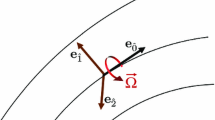Abstract
In analogy with Planck’s construction of fundamental quantities in gravitation, we construct fundamental quantities associated with (1) theories of electrodynamics in which the electromagnetic field has a maximum value (e.g. Born-Infeld theory), and (2) the Fermi interaction. This gives us a maximum intensity of the electromagnetic field, and also reveals a close relationship between the fundamental lengths associated with the gravitational and weak interactions, supporting the connection between these two interactions.
Similar content being viewed by others
References
Planck, M.: Vorlesungen über die Theorie der Wärmestrahlung. J. A. Barth, Leipzig, 163 (1906). (English translation: The Theory of Radiation, 1959, Dover.)
Born, M.: Modified field equations with a finite radius of the electron. Nature (London) 132, 282 (1933)
Born, M.: On the quantum theory of the electromagnetic field. Proc. R. Soc. A 143, 410 (1934)
Born, M., Infeld, L.: Foundations of the new field theory. Proc. R. Soc. A 144, 425 (1934)
Sorokin, D.: Introductory Notes on Non-linear Electrodynamics and its Applications. In: arXiv: 2112.12118 [hep-th]
Bretón, N.: Nonlinear electrodynamics and cosmology. J. Phys. 229, 012006 (2010)
Novello, M., Perez Bergliaffa, S.E.: Bouncing Cosmologies. Phys. Rept. 463, 127 (2008); Preprint in arXiv: 0802.1634 [astro-ph]
Choquet-Bruhat, Y., DeWitt-Morette, C., Dillard-Bleick, M.: Analysis, Manifolds and Physics. Elsevier, Amsterdam (1996)
Padmanabahn, T.: Physical significance of Planck length. Ann. Phys. 165(1), 38 (1985). (and references therein)
Schwinger, J.: On gauge invariance and vacuum polarization. Phys. Rev. D 82, 664 (1951)
Shabad, A.E., Usov, V.V.: Positronium collapse and the maximum magnetic field in pure QED. Phys. Rev. Lett. 96, 180401 (2006)
Stuckelberg, E. C. G.: private communication
Novello, M., Hartmann, A.: From weak interaction to gravity. Int. J Mod. Phys. A 36(7), 2150051 (2021)
Acknowledgements
MN and VA would like to thank the Brazilian agencies Faperj and CNPq for their financial support.
Author information
Authors and Affiliations
Corresponding author
Additional information
Publisher's Note
Springer Nature remains neutral with regard to jurisdictional claims in published maps and institutional affiliations.
Rights and permissions
Springer Nature or its licensor (e.g. a society or other partner) holds exclusive rights to this article under a publishing agreement with the author(s) or other rightsholder(s); author self-archiving of the accepted manuscript version of this article is solely governed by the terms of such publishing agreement and applicable law.
About this article
Cite this article
Novello, M., Antunes, V. Fundamental Units in Gravitational, Electromagnetic and Weak (Fermi) Interactions. Found Phys 54, 16 (2024). https://doi.org/10.1007/s10701-023-00741-7
Received:
Accepted:
Published:
DOI: https://doi.org/10.1007/s10701-023-00741-7




